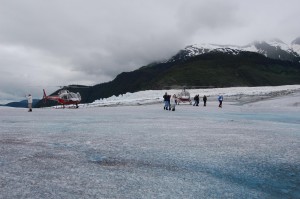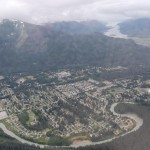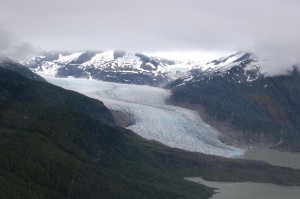
The Mendenhall Glacier ends its 12-mile journey at Mendenhall Lake, which in turn flows toward the coast.
By Henry M. Holden
In July, my wife, Nancy, and I took a cruise to Alaska from Seattle onboard Holland America’s ms Öosterdam. We left on a Friday; on Monday, we disembarked in Juneau and took a tour bus to TEMSCO Helicopters, Inc., at Juneau International Airport (JNU) for a helicopter flight to Mendenhall Glacier.
We arrived at the TEMSCO heliport unsure of what to wear or bring along for a helicopter ride to a block of ice. The folks on the ship told us it was 64 degrees in Juneau and to dress in light layers of clothing, wear a hat, sunglasses and gloves. Oops — it was 85 degrees when we left New Jersey, and we never gave a thought to bringing gloves.
The first thing we did on arriving was sit down for a safety briefing and a review of conditions on the glacier. Because of the weight restrictions of the helicopter, everyone had to include their real body weight along with any equipment on the manifest. TEMSCO didn’t allow bags or parcels, but did provide secure storage for them. We could only carry cameras or binoculars.

The ice beneath the helicopter could be more than 3,000 feet thick. As we got closer, it was clear that the ice was violently broken, creviced, gouged and torn.
We then selected appropriate glacier boots, provided by TEMSCO, which slip on over regular shoes. The boots have spikes, which dig into the ice and prevent slipping and falling. One repeated caution was not to back up when taking a picture; there are holes and crevasses on the ice, which are deceptively shallow and filled with water. It’s easy to twist an ankle, or worse, fall in one of them.
Lessons on how to walk in these awkward but necessary booties was the next order of business, including how to walk up and down the ice hills while maintaining a reasonably upright position.
“You don’t have to be an in-shape 20-year-old,” Tim McDonnell, the company’s vice president of tours, said. “You can walk on a glacier. It’s the 8th wonder of the world.”
After the briefing, we lined up on the ramp while the fleet of four American Eurocopter LLC AS350 Astar helicopters landed with people returning from a previous tour.

As the helicopter flew closer to the base camp, the ice revealed itself as small but rugged hills with a strange aqua-blue glow in parts.
“It’s the Cadillac of flight-seeing helicopters,” McDonnell said. “Lots of glass, and it’s much quieter than other models.”
TEMSCO, a founding member of the Helicopter Tour Operators Program of Safety, is safety minded. The TOPS Program of Safety implements best management practices to make safety the top priority, including flight routes and landing sites, since they may vary due to weather and glacier conditions. TOPS’ requirements exceed the requirements of the Federal Aviation Regulations for Part 91 and Part 135 operations. TEMSCO also operates under a USDA Forest Service Special Use Permit in the Tongass National Forest.
Each passenger must follow a specific yellow-outlined path to board the helicopters, since the rotors are turning during boarding and deplaning.
Scrambling into our assigned seats, we each donned a headset to communicate with our pilot, Randy Hill, and with other passengers during the 20-minute flight to the glaciers. Several first-time helicopter passengers were surprised to find the headphones drown out the sound of the rotors.
The passengers buckled their seat belts and heard a few final cautionary words about helicopter safety from our pilot. Hill is one of 30 pilots who fly 17 tour helicopters from Juneau and Skagway. TEMSCO requires its pilots to have at least 1,000 hours as a pilot-in-command. Hill spooled up the rotors; the helicopter rose effortlessly, and then shot east toward the Juneau Icefield.
TEMSCO Helicopters is the most experienced helicopter touring company in Alaska. Established in 1958 by Ken Eichner, TEMSCO was the first helicopter company to create the original helicopter glacier tour in Alaska in 1983.
TEMSCO started as an industrial helicopter company. Its name is an acronym for timber, exploration mining, survey, cargo and operations. According to tour manager Eric Schultz, about 50 percent of its business comes from tours, and lately a large portion of its business services go to power line installation. TEMSCO also flies for utility work, firefighting and Forestry Service operations. Its glacier trips have grown popular enough to support a separate tourism division of the company. TEMSCO offers a variety of excursions, from a 30-minute walk on Mendenhall Glacier to a visit to a dog camp on the glacier, complete with dog-sled ride.

These passengers have no idea what’s at the end of their walk. Is it a drop-off, or a big melt-water pool?
Moments after departing the field, we were treated to breathtaking vistas seen by only those who venture above. The alpine ridges and mountain peaks created a dramatic backdrop for awe-inspiring Mendenhall Glacier. We skirted a temperate and thriving rain forest, which slid away as we approached the ice. The ice seemed to lap the mountain’s sides and spread its tentacles among the jagged mountain peaks.
Are the glaciers melting?
During the Great Ice Age, several climate fluctuations nourished the advance and retreat of the glaciers, and vast sheets of ice enshrouded nearly one-third of the Earth and half of Alaska. The Juneau Icefield feeds 38 major glaciers, including the uncommonly accessible Mendenhall. Despite its apparent permanence, Mendenhall Glacier is only about 3,000 years old — a mere second or two on the geologic clock. Its forward movement ended about 1700, and for the last 300 years, it’s been in retreat.

An aquamarine glow seeps out from fissures as if the ice were a chilled lifeform. The snow accumulates & compacts into solid ice, causing changes in volume, density & crystal structure, which prevents the ice from absorbing the color blue wavelength.
The Mendenhall Glacier flows out of the larger Juneau Icefield that stretched eastward for thousands of square miles. About 12 miles long, and at points more than 3,000 feet thick, Mendenhall is not among the largest of Alaska’s tens of thousands of glaciers.
The annual snowfall on the Juneau Icefield often exceeds 100 feet. Mild southeast summers often cause winter snow accumulation at higher elevations to exceed the summer snowmelt. The snow accumulates and compacts into solid ice, causing changes in volume, density and crystal structure, which prevents the absorption of the color blue wavelength, accounting for the blue tint seen in the ice.
While “global warming” is a loaded term these days, the science behind it is by no means settled. There’s general agreement among scientists that the Earth’s atmosphere varies in cycles and that it’s currently warming. There’s also agreement that the most noticeable effects of this warming are occurring in Earth’s highest and lowest latitudes. So what we were seeing, according to our guide, was a glacier melting at its terminus and growing further east.
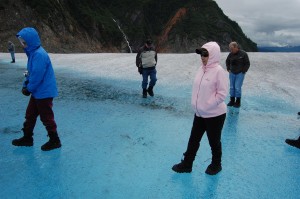
My wife and others are standing on ice a mere 350 feet thick at the terminus, where it begins its liquid flow toward the coast. With the wind chill, the temperature was 20 degrees—a real winter experience in July.
Even if global warming has triggered a glacial meltdown, as some scientists believe, visitors to Juneau still have plenty of time to take in this wonder of Mother Nature before the last chunk of ice floats downstream.
Weather is always a factor in aviation
It was a breezy day with the ceiling at 2,200 feet, and we skirted the bottom part of the overcast.
“While Part 135 requires 500 feet for visibility, we always fly above 1,500 feet,” Eric Eichner, grandson of the company’s founder, said. “We’re close to the city of Juneau and respect the noise abatement issues it has, and we’re more comfortable flying higher over the glacier.”
Our flight took us over the glacier itself; the helicopter’s perspective gave us an eagle’s-eye view of ice spires, deep blue crevasses and melt-water pools. As we descended, we began to comprehend the enormity of the glacier. The shapes of the ice are random. There are icefalls hanging from sheer cliffs, bearing names such as Wonderland, Glacier King, the Mendenhall Towers and the Devil’s Paw. Descending toward the landing site, we flew past the Mendenhall Towers — rock sentinels that soar to nearly 7,000 feet.
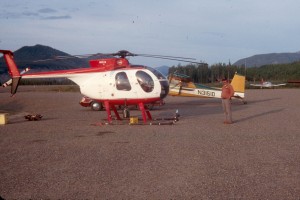
Ken Eichner, TEMSCO founder, poses with two of his favorite modes of transportation. Eichner was active in his company—and as a pilot—until 2007, when he passed away just short of 88.
The Mendenhall Glacier is an enigma and a place that’s unforgettable. The ancient landscape seems to be living. It’s a river of ice that actually has the feel of a river. The shapes are unpredictable; from above, the surface seemed smooth, but as our helicopter descended closer, the ice revealed itself violently broken, creviced, gouged and torn. The colors are eerily like those of a distant planet. Snow white, but also brown, from rock scraped from the mountainsides. A glowing aquamarine color seeps out from fissures and holes as if it were plasma of a chilled life.
What makes Mendenhall unique is the different options people have to visit it. It’s only 13 miles from downtown Juneau; a city bus travels to the Visitor’s Center, where you can look across the lake at the ice flow. Juneau has become a major stop for Alaska cruises — from May through September, more than 900,000 passengers will dock there. These travelers can choose from dozens of shore excursions, from salmon bakes to dog sledding to jewelry shopping. By sheer numbers, Mendenhall is the most popular — around 400,000 tourists visit the glacier each year. About 45,000 of those visitors take TEMSCO’s helicopter tour, according to Eichner.

This meltwater pool is deceptively shallow and dangerous to step in. The brown specks are from rock scraped from the mountainsides.
The unease some passengers expressed about traveling to the glacier vanished as they clomped around in glacier boots. They joined the rest of us in awe and understanding as our guide discussed the geology of the area. Topography and gravity draw the ice into the valleys below, the glaciers carving the land as they go. It’s a geology lesson that will last well beyond the visit.
It takes about 80 years for the glacier to complete the journey from its mountain birth source to the modest-size lake it created within Juneau’s city limits. We stood on ice a mere 350 feet thick at the terminus where it begins its liquid flow toward the coast.
Glacier walking is the closest sensation I ever expect to compare to walking on a distant planet. It’s an awe-inspiring, timeless landscape that glacier scientist, Dr. Maynard Miller, described as a “sense of the eternity of the universe around you.”
A moderate breeze added to the chill. I zipped up my thin jacket and noticed others also doing the same. Some, like my wife, had purchased a jacket with a hood onboard the ship, and they faired much better in the 20-degree wind chill.
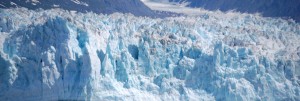
The glacier is like a fingerprint—no two shapes are identical. The reflected blue wavelength is obvious in this ice.
Our guide casually suggested we could drink the water if anyone wanted to try this during our walkabout and discussion of glacier geology. Only two people out of six on my flight volunteered. I was one of them. Not surprisingly, it tasted like very cold water.
By the time we picked our way past a series of deep crevices filled with brilliant aqua-blue water, navigated across a few sun-melting streams, and urged our legs in the direction of the landing site, it was hard to believe we had been walking around on a glacier. We bid farewell to our guides and climbed aboard Hill’s helicopter to complete the loop — an exhilarating ride above Mendenhall Glacier, right over its face, across beautiful Lake Mendenhall and back to JNU. Skirting the city, all pilots obey the 1500-foot rule and don’t cross over the city, which would have been the faster way back.
The tour includes approximately 20 to 25 minutes on the Mendenhall Glacier, for a total time of about one hour. Allow up to 45 minutes for transportation from dock departure and return to the dock.
Bring plenty of film (or a large memory card for the digital gang) and batteries — this is an amazing opportunity to take once-in-a-lifetime photos on an unforgettable journey.
For more information, visit [http://www.temscoair.com].
- Founded in 1958, TEMSCO Helicopters’ name comes from timber, exploration mining, survey, cargo and operations. It also works on projects with the U.S. Forest Service.
- A light rain is smearing the canopy as we pass to the side of Juneau on our way to the heliport. Noise abatement procedures kept us above 1,500 feet on the return leg to JNU.
- Two tour helicopters (9:00 a.m.) are returning to the heliport where passengers were dropped off and members of a new tour boarded within minutes.












